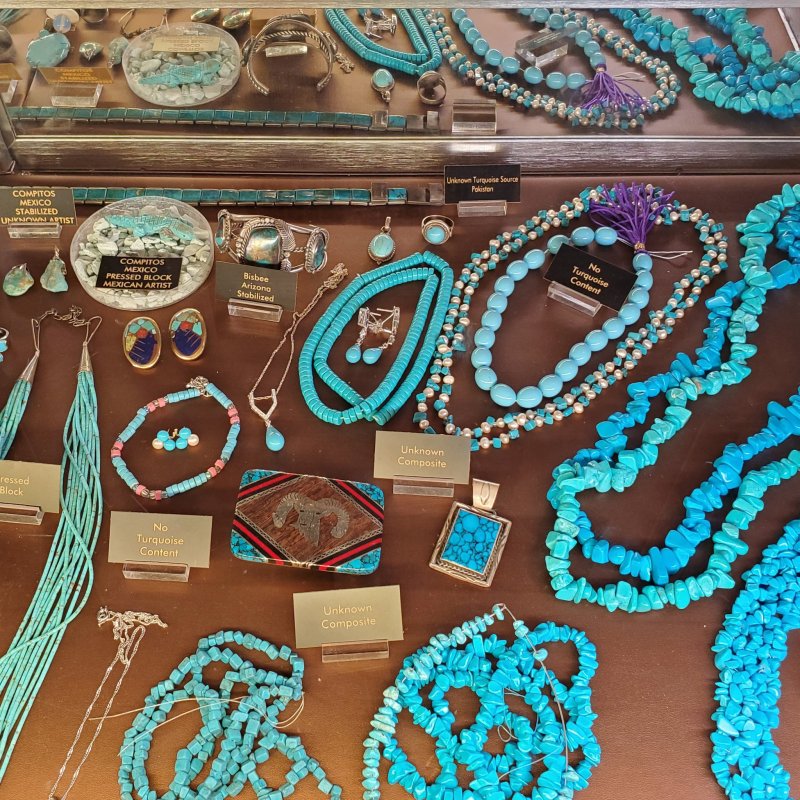
The world’s turquoise supply is limited, the ad said. It urged me to buy a piece of turquoise jewelry sooner rather than later. The “snooze, you lose” message wasn’t subtle.
Videos by TravelAwaits
The ad implied I had discriminating taste if I wore turquoise. I’d follow in the footsteps of Native American shamans who understood the healing power of turquoise. Or I’d be akin to European royalty who were introduced to turquois, meaning Turkish, when the gemstone came from Persia via Turkey in the 17th century.
Like many gemstones, turquoise’s popularity waxes and wanes depending on whether the color turquoise is trending. But for collectors or those mesmerized by the stone, it never goes out of style.
On a recent trip to Albuquerque’s Turquoise Museum, curator and leading turquoise expert Joe Dan Lowry and I talked about all things turquoise, including its rarity. In case you’re wondering, yes, it is one of the rarest gemstones. As Lowry pointed out, diamonds are sold in every jewelry store in every mall in America. That’s definitely not the case with turquoise.
When it comes to buying turquoise, knowledge is power. If you’re in Albuquerque, begin, like I did, with a guided tour of the Turquoise Museum or read on for tips to help you find the best turquoise jewelry — for you — in New Mexico.

1. Explore The Looks Of Turquoise
A tour of the Turquoise Museum will open your eyes to the range of turquoise’s colors with stones from more than 90 mines on six continents. From milky white, light brown, and apple green to powder blue and deep turquoise, they’re all turquoise stones. Persian robin’s egg blue, which became Tiffany and Co.’s signature color, is on display, too.
What about the matrix and inclusions? The matrix is the system of lines running through the stone. As the stone forms over the course of up to 5,000 years, naturally occurring veins fill up with minerals, according to Lowry. Inclusions are pockets of minerals within the turquoise. Like colors, stones range from no matrix or inclusions to those that are loaded with matrix or inclusions in either random or uniform patterns.
Tiffany Blue turquoise has very little matrix. In the 1890s, mines sprung up in the Southwest to fill Tiffany and Co.’s growing need for turquoise with this look. The turquoise that miners unearthed in New Mexico, Arizona, Nevada, Colorado, and California each had colors, matrices, and inclusions unique to the mine. None looked like Tiffany’s Persian variety.
As the West became a destination for train travelers and, later, road trippers on Route 66, the turquoise that Native Americans had traded and set in healers’ necklaces became the turquoise we now expect to see inlaid in sterling silver in the American Southwest.
2. Understanding Grades
When it comes to choosing the color and amount of matrix in turquoise, what appeals to you is what matters. But the price you’ll pay for a cabochon (cut and polished turquoise) will depend upon its grade and rarity.
Diamonds are graded by carat, cut, clarity, and color the world over. Turquoise is graded with two systems — the Persian system and the American system. The bottom line is a stone with the most clarity and deepest blue is graded highest, but the mine the stone comes from and how rare the stone is (for instance, whether the mine has limited deposits or is still being excavated) all factor into the stone’s value.
3. Natural Or Not
It can certainly be a challenge to know the turquoise-colored stone in a piece of jewelry is indeed turquoise.
While I toured the Turquoise Museum, Lowry explained that only about 15 percent of the turquoise coming out of the ground is usable. This is called natural turquoise. The remaining 85 percent is too soft to be cut or polished as is. It can be added to epoxy or resin to create usable turquoise that can be cut into cabochons. In the process, color can be added or the stone can be cooked in wax or oil to deepen its blue or green color.
There are manufactured stones on the market, too, in which the minerals found in the natural gemstone are combined to create turquoise. To the uneducated eye, they look like the real thing.
And there are imitations made from glass or plastic which may or may not be realistic enough to fool you.

4. Ask Questions
Natural turquoise ranges in price from inexpensive to very pricey, depending on the stone’s grade and whether or not the stone is still being mined. Meanwhile, some manufactured stone has become valuable.
So price alone won’t signal if the stone is natural turquoise or not. And “natural” is the keyword. If you ask for “natural” as opposed to “real” turquoise, you are asking for turquoise that has been mined and not altered to make it harder or deeper in color.
Natural stone is not oiled or waxed. It has not been added to resin or epoxy to allow it to be cut and polished. It has not been dyed. And is not manufactured. It is a naturally-occurring stone that has been cut and polished only.
The federal Indian Arts and Crafts Act says it’s illegal for jewelry to be labeled as Native American Jewelry if it isn’t made by a member of one of the federally-recognized tribes. Since so much of the Native American jewelry in New Mexico includes turquoise, New Mexico’s Indian Arts and Crafts Act (PDF) includes the requirement to disclose what materials were used in the jewelry.
5. Get It In Writing
Once you’ve decided on a piece of turquoise jewelry, Lowry recommends you get a receipt with date, price, and jeweler’s information along with the following in writing:
- The artist’s name (it’s often engraved on the jewelry)
- The artist’s tribal affiliation
- The name of the mine the turquoise came from
- Whether the turquoise is natural, stabilized, or enhanced
With vintage turquoise jewelry, some of this information won’t be available, but the jeweler should still provide you with the grade of the stone, whether it is natural or not, and its appraised value.
If the jeweler isn’t willing to give you a certificate or description of the turquoise, you probably aren’t buying what you think you are.
6. Shop In Reputable Galleries
If you are interested in buying jewelry with turquoise that can be verified, you’ll need to head to a reputable jeweler. Here are some recommendations throughout New Mexico:
Albuquerque
The Turquoise Museum gift shop sells natural turquoise from their U.S. mines and from international sources. Here you can buy both turquoise jewelry and cabochons. For an online shopping experience, visit the Lowry Family Collection. Prices reflect the grade and rarity of the turquoise. Purchases include a certificate of authenticity.
Gertrude Zachary’s gallery also features rare turquoise. Zachary not only designed jewelry with a modern twist, but she also purchased and stockpiled rare turquoise from mines that no longer produce turquoise or whose deposits were almost gone. She passed away in 2013, but artists continue to use her designs as well as their own to showcase valuable turquoise from Number Eight, Morenci, and Bisbee Mines.
Santa Fe
Tsali Hall curates fine turquoise jewelry for Palace Jewelers at Manitou. Much of the stone comes from the Lowry Family Collection, which means the mine the turquoise came from and the carat weight are part of a letter of authenticity, as well as the Native American artist. They have an online store that allows you to see their jewelry organized by artist. If you really feel like going shopping, they also have artwork, including mini-sculptures. There’s something for every budget.
Shiprock Santa Fe sells Native American-made inlaid jewelry using different colors of turquoise and other stone. They also sell vintage and antique turquoise jewelry, which typically does not include a certificate with the turquoise’s origin or the jewelry’s artist.
Ann Thomas from Sunwest on the Plaza says, “turquoise is a stone that speaks to people.” Their turquoise is sourced from gallery owner Ernie Montoya’s American mines as well as Egypt and Kazakhstan. Each Saturday at high noon, the gallery hosts a live shopping event on their Facebook page.
Gallup
Richardson Trading Post has a large collection of Native American-made sterling and turquoise jewelry. Their jewelry is signed by the artist, and the store notes whether the stone is natural or enhanced on the receipt.
Vanderwagen
Nineteen miles south of Gallup, Joe Milo’s Trading Company specializes in turquoise from the American Southwest and Mexico. They provide certificates of authenticity. Their online shop shows just a small portion of their inventory, and the item’s description includes the mine.

7. Buy From Respected Artists
I asked Lowry, Hall, and Thomas who the established and up-and-coming turquoise artisans are — ones that are creating jewelry that will stand the test of time in both design and workmanship.
Keep an eye out for jewelry by brothers Kyle, Trent, and Wyatt Lee-Anderson, Wes Willie, Emmett Navakuku, and Bryan Tom, or find an artisan whose style speaks to you and is represented in a reputable gallery.
Pro Tip
If the price is too good to be true, ask more questions. If the seller isn’t willing to put the turquoise’s pedigree on paper, it’s probably not natural stone. There’s nothing wrong with altered, manufactured, or imitation turquoise as long as it’s disclosed and you’re paying a fair price for it. Remember, New Mexico’s Indian Arts and Crafts Act protects you.
